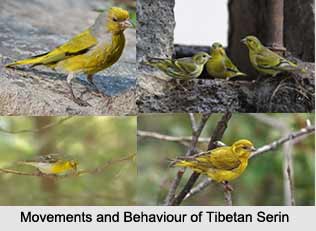 Tibetan Serin is an Indian bird that bears a scientific name `Spinus thibetanus". It is also named as Tibetan Siskin. It is a true finch species.
Tibetan Serin is an Indian bird that bears a scientific name `Spinus thibetanus". It is also named as Tibetan Siskin. It is a true finch species.
Description of Tibetan Serin
The first description of Tibetan Serin was by the British ornithologist Allan Octavian Hume in 1872 under the binomial name Chrysomitris thibetanus
Category of Tibetan Serin
Tibetan Serin was formerly placed in the genus Serinus but was assigned to the genus Spinus based on a phylogenetic analysis of mitochondrial and nuclear DNA sequences.
Structure of Tibetan Serin
Tibetan Serin has the length which is around 12 cm (4.7 in). Tibetan Siskin lacks yellow panels on wing in all plumages. The adult male has olive-greenish upperparts, yellow under parts, yellowish-green rump, yellow supercilium and border behind ear-coverts. Wing and tail feather of this bird species are broadly differentiated by yellowish-green colour. While females of this species has black streaking on darker greyish-green upperparts, more clearly defined wing-bars than their male counterparts, paler yellowish throat and black flanked breast with streaking. Juveniles are duller green, tinged brownish-buff on upperparts, with duller rump, buff fringes to greater coverts and paler or heavily streaked underparts.
Concentration of Tibetan Serin
Tibetan Serin is found in Bhutan, China, India, Myanmar, and Nepal. Its natural habitat is temperate forests.
Habitat of Tibetan Serin
In winters Tibetan Serin spent in central and eastern Himalayan Mountain Range. A group of birders from West Bengal found its presence in Hee Village near Varsey Rhododendron Sanctuary, Sikkim in the month of March 2013.
Breeding of Tibetan Serin
Tibetan Serin breeds in mixed forest and spend their winter in alder.



















